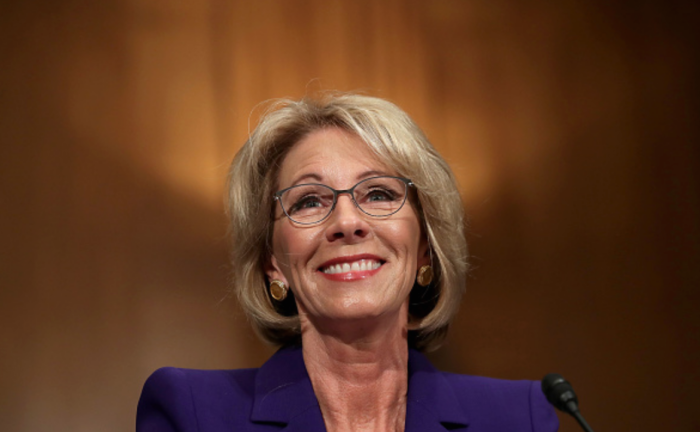
Guns were not allowed at Donald Trump’s inauguration.
They were not allowed at his speech to the National Rifle Association (NRA).
Nor were they allowed at the Conservative Political Action Conference (CPAC) or at most of his hotels, golf courses and other properties.
But he wants them to be allowed at our public schools.
He promised to eliminate gun free zones at schools around the country on day one of his presidency.
With all the tweeting about crowd size, he didn’t get around to it. But he may – soon.
Press Secretary Sean Spicer promised in February that the President has an executive order in the works to address the issue.
Before running for Chief Executive, Trump had been much more moderate on guns. But since then he has echoed the NRA’s official position several times, saying that there are fewer shootings in areas where guns are permitted and that killers target areas prohibiting them.
However, it’s not true. From 2000 to 2013, only one shooting was stopped by an armed civilian. However, during that time, 21 shootings were stopped by unarmed bystanders. Moreover, from January 2009 to July 2015, only 13 percent of mass shootings took place in gun-free zones.
The law prohibiting guns in schools (with the exception of mostly law enforcement officers) was signed by Republican President George H. W. Bush in 1990. The law was upheld in 1995 by the U.S. Supreme Court.
So for now, it is illegal for unauthorized people to posses firearms inside or around a school.
Trump’s Education Secretary Betsy DeVos may have given everyone a good laugh suggesting schools need guns to protect from bear attacks, but Republicans are working to make this a reality – with or without the President. In January, Rep. Thomas Massie (R-Ky.) introduced a bill to repeal this legislation.
The question remains, are guns in school a good or bad idea? In a country of 350 million people and more than 310 million guns, would our schools really be safer if those firearms ended up in our classrooms?
F- NO!
Here are five reasons why:
1) Kids Will Get Ahold of Them
Kids get their hands on everything. As a parent, it’s exceedingly difficult to put anything down without your children ending up with it. And that’s only with one or two kids! Imagine it with a classroom of 20-30!
Look at how many times teachers’ cell phones unintentionally end up in student hands. It’s human nature. If kids know a teacher is packing, some of her students may go through her desk, her bag or otherwise find it.
Moreover, teachers often have to break up fights between students. Having a gun within reach of angry adolescents bent on doing each other harm is a recipe for disaster.
Unfortunately, children are not strangers to gun violence. According to FBI homicide data, of the 1,448 children who died as a result of gun violence in 2010, 165 of those deaths were at the hands of other children.
In most cases, trained teachers will keep firearms out of reach, but having them present in the classroom increases the chances of tragedy.
This is backed up by social science. The Journal of Pediatrics conducted a study in 2001 where twenty-nine groups of two to three boys, most of whom were around ten-years-old, had to wait for fifteen minutes in a room with a one-way mirror. Two water pistols and a real handgun were partially hidden in various locations throughout the room. If students found the handgun and pulled the trigger, it was rigged to make a firing sound and kickback realistically.
The result: 48 out the 64 boys found the handgun. Of those, 30 handled the gun and 16 pulled the trigger. Approximately half of the boys who found the gun said they thought it was a toy or were unsure if it was real. A full 90% of the boys who handled the gun or pulled the trigger had received some sort of gun safety education previously.
Make no mistake. Having guns within reach of children is an invitation for them to use them.
2) Schools Don’t Want Them
Most schools don’t want this responsibility.
Back in 2012, Michigan Republicans floated a bill to allow guns in schools. Superintendents throughout the state sent letters to Gov. Rick Snyder asking him to veto it (which he did). The American Federation of Teachers (AFT), one of the largest labor unions in the country with more than 1.5 million members, also wrote to Snyder, saying, “We should be doing everything we can to reduce the possibility of any gunfire in schools and concentrate on ways to keep all guns off school property.”
They know that guns in school will increase problems – not decrease them. Survivors of school shootings certainly aren’t coming forward demanding more guns. We should listen to them.
3) Teachers Will Misuse Them
Teachers are highly trained and have years of experience helping kids learn. They aren’t necessarily knowledgeable with how to safely use, store and operate firearms. Nor would some of them be suited to such training.
Everyone’s known those teachers who are lovably absentminded. Do you want them leaving their gun in an unlocked classroom? Just because you can help a student read and write, doesn’t mean you’re good in a gunfight.
I love teachers. I admire most of the educators in my building. I would not feel safe if they were all armed.
4) Kids Will Be Scared
Having a gun in class does not put people at ease. It does just the opposite. A gun is a threat of future violence. If students completely trust their teacher, they may be comforted, but students rarely feel that level of comfort with every teacher in the building.
Imagine the chilling effect a firearm can have on class discussion, on any sort of disagreement. Some students are victims of abuse at home and don’t fully trust adults. At present, the worst a teacher can do is just fail them. How would these children feel living with the threat of imminent death? In most states, teachers aren’t even allowed to paddle students anymore. Now we’re going to give them the power of life and death!?
How would parents feel? I love my daughter’s teachers, but I must admit I don’t want them strapped.
5) They Won’t Stop School Shootings
Most school shooters don’t pay much attention to whether they will survive their attack. In fact, they plan for just the opposite. The presence of guns will not deter them. It may even attract them.
Sometimes violence is a cry for help. Children act out not to achieve their aim but to be stopped by an adult. Having guns in school may make students feel safer about initiating a shooting because they think they’ll be apprehended.
Moreover, it makes the job of police responding to a shooting that much more difficult. How can they tell the difference between an armed perpetrator and an armed victim? Plus there’s the issue of friendly fire. When you have two people shooting at each other, bystanders get caught in the crossfire. This is not a good environment for children.
Critics will say it’s better than just the perpetrator being armed, but that’s the point. It’s better that NO ONE be armed at school.
Instead of increasing firearms around children, we should decrease and control them. But that’s a policy driven by rationality and not the profits of gun manufacturers.
This entire debate has been driven by what’s economically beneficial for one industry over everything else. Money has trumped science, reason and empathy.
If Republicans think guns are so vital, maybe they should pass laws to allow them at their own gatherings before forcing them on our public schools.
Children deserve a safe environment in which to learn. Adding guns to our already overburdened public schools is throwing a match at an already explosive situation.
















